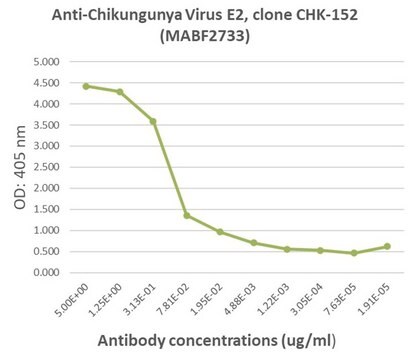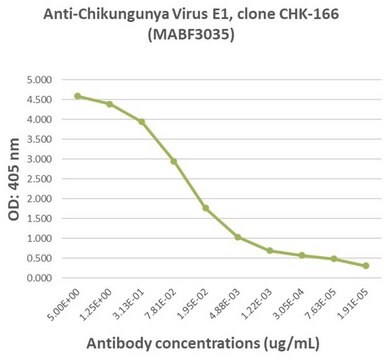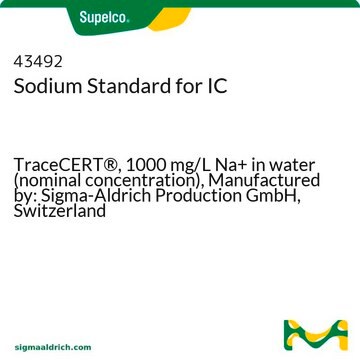MABF2052
Anti-Chikungunya virus Antibody, clone 3E7b
clone 3E7b, from mouse
Synonyme(s) :
CHIKV
About This Item
Produits recommandés
Source biologique
mouse
Forme d'anticorps
purified immunoglobulin
Type de produit anticorps
primary antibodies
Clone
3E7b, monoclonal
Espèces réactives
virus
Conditionnement
antibody small pack of 25 μL
Technique(s)
ELISA: suitable
immunocytochemistry: suitable
neutralization: suitable
western blot: suitable
Isotype
IgMκ
Modification post-traductionnelle de la cible
unmodified
Description générale
Spécificité
Immunogène
Application
Inflammation & Immunology
Immunocytochemistry Analysis: A representative lot detected Chikungunya virus in Immunocytochemistry applications (Lam, S., et. al. (2015). MAbs. 7(6):1178-94).
Immunocytochemistry Analysis: A 1:100 dilution from a representative lot detected Chikungunya virus in BHK cells infected with Chikungunya virus. (Courtesy from an independent lab).
Neutralizing Analysis: A representative lot neutralized Chikungunya virus in Neutralizing applications (Lam, S., et. al. (2015). MAbs. 7(6):1178-94).
ELISA Analysis: A representative lot detected Chikungunya virus in ELISA applications (Lam, S., et. al. (2015). MAbs. 7(6):1178-94).
Qualité
Isotype Analysis: The identity of this monoclonal antibody is confirmed by isotype test to be mouse IgMk.
Forme physique
Stockage et stabilité
Autres remarques
Clause de non-responsabilité
Not finding the right product?
Try our Outil de sélection de produits.
Certificats d'analyse (COA)
Recherchez un Certificats d'analyse (COA) en saisissant le numéro de lot du produit. Les numéros de lot figurent sur l'étiquette du produit après les mots "Lot" ou "Batch".
Déjà en possession de ce produit ?
Retrouvez la documentation relative aux produits que vous avez récemment achetés dans la Bibliothèque de documents.
Notre équipe de scientifiques dispose d'une expérience dans tous les secteurs de la recherche, notamment en sciences de la vie, science des matériaux, synthèse chimique, chromatographie, analyse et dans de nombreux autres domaines..
Contacter notre Service technique








![Refractive index standard traceable to NIST, traceable to PTB, [α]/D 60°, Brix CERTIPUR®](/deepweb/assets/sigmaaldrich/product/images/137/112/c7ee9f1e-5b1a-475f-9853-3595c8466217/640/c7ee9f1e-5b1a-475f-9853-3595c8466217.jpg)